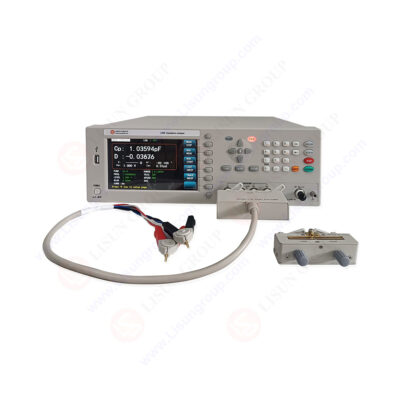

This article provides an in-depth analysis of the LISUN LS90 Impedance Analyzer, focusing on its role as an impedance meter in the evaluation of electronic components. The importance of impedance measurement in ensuring the quality and performance of components is highlighted, along with detailed specifications, key features, and application scenarios of the LISUN LS90. Data tables are included to demonstrate the analyzer’s capabilities, emphasizing its relevance in research, development, and quality control.
1. Introduction
Impedance measurement plays a crucial role in the electronics industry, helping to assess the performance of components like capacitors, inductors, and printed circuit boards (PCBs). An impedance meter, such as the LISUN LS90 Impedance Analyzer, is essential for accurate and reliable measurements, ensuring the functionality and reliability of electronic systems. This article explores the capabilities and applications of the LISUN LS90 impedance meter, emphasizing its value in modern electronic testing environments.
2. Overview of Impedance Meters
Impedance meters are specialized instruments used to measure the impedance, resistance, inductance, and capacitance of electronic components. The LISUN LS90 Impedance Analyzer, a versatile impedance meter, provides highly precise measurements across a wide frequency range, making it an ideal choice for both research and industrial applications.
3. Technical Specifications of the LISUN LS90 Impedance Meter
The LISUN LS90 Impedance Analyzer is designed to offer accurate and consistent impedance measurements. Below are the detailed specifications of this impedance meter:
Parameter
Specification
Model
LS90
Frequency Range
20 Hz – 120 MHz
Impedance Range
0.01 Ω – 100 MΩ
Measurement Parameters
Z, R, X, Y, θ, L, C, D, Q
Basic Accuracy
0.05%
Test Signal Level
10 mV – 2 V
Measurement Speed
Fast: 10 ms, Medium: 100 ms, Slow: 1 s
Display
7-inch color LCD
Interface
USB, LAN, GPIB, RS232
Power Supply
AC 220V ±10%, 50Hz/60Hz
Dimensions (W x D x H)
420mm x 380mm x 200mm
Weight
Approximately 15 kg
LS90_Impedance analyzer
4. Key Features of the LISUN LS90 Impedance Meter
• Wide Frequency Range: The impedance meter operates from 20 Hz to 120 MHz, covering a broad spectrum of applications.
• High Measurement Accuracy: With a basic accuracy of 0.05%, the analyzer provides highly reliable impedance measurements.
• Multiple Measurement Parameters: The impedance meter can measure impedance (Z), resistance (R), reactance (X), admittance (Y), phase angle (θ), inductance (L), capacitance (C), dissipation factor (D), and quality factor (Q).
• Flexible Test Signal Levels: Allows adjustment of test signal levels from 10 mV to 2 V, accommodating various testing requirements.
• High-Speed Measurements: Offers selectable measurement speeds to optimize between speed and accuracy based on the testing scenario.
5. Applications of the LISUN LS90 Impedance Meter
The LISUN LS90 Impedance Meter is widely used in component testing, material analysis, and quality control. Its versatility makes it suitable for industries such as consumer electronics, telecommunications, automotive, and aerospace.
6. Testing Procedures and Methods
The typical testing procedure with the LISUN LS90 impedance meter involves several steps:
• Setup: The component is connected to the test ports, and the appropriate measurement parameters (frequency, test level) are configured.
• Calibration: The impedance meter is calibrated using standard reference components to ensure measurement accuracy.
• Measurement: The impedance analyzer performs the measurement, displaying real-time data on the component’s impedance, phase angle, and other parameters.
• Data Analysis: Collected data is analyzed to determine component characteristics and performance, identifying any deviations from expected values.
7. Performance Evaluation: Impedance Meter Data Analysis
The following table summarizes typical data obtained from the LISUN LS90 impedance meter during testing of various components.
Component
Test Frequency (MHz)
Measured Impedance (Ω)
Phase Angle (°)
Quality Factor (Q)
Capacitor (1 µF)
1
15
-89
0.1
Inductor (10 µH)
10
6
88
50
Resistor (100 Ω)
1
100.05
0
N/A
PCB Trace
50
0.25
-45
2
Ferrite Core
5
2.5
70
8
8. Benefits of Using the LISUN LS90 Impedance Meter
Enhanced Measurement Accuracy: The high precision of the impedance meter ensures reliable component evaluation.
Comprehensive Testing Capabilities: Capable of measuring a wide range of parameters, making it suitable for diverse testing requirements.
Time Efficiency: High-speed measurement options reduce testing time, enhancing productivity in R&D and manufacturing settings.
Data Connectivity: Multiple interface options enable easy integration with other testing equipment and data management systems.
9. Conclusion
The LISUN LS90 Impedance Analyzer is a powerful impedance meter that plays a vital role in the testing and analysis of electronic components. Its broad frequency range, high accuracy, and versatile measurement capabilities make it an essential tool for engineers and researchers. By providing comprehensive data on impedance and related parameters, the LISUN LS90 impedance meter helps ensure the performance and quality of components, supporting the advancement of technology in various fields.
References
LISUN Group. (2024). Impedance Analyzer. Retrieved from LISUN Impedance Analyzer. https://www.lisungroup.com/news/technology-news/comprehensive-analysis-of-impedance-meter-the-lisun-ls90-impedance-analyzer.html


Comments
Post a Comment